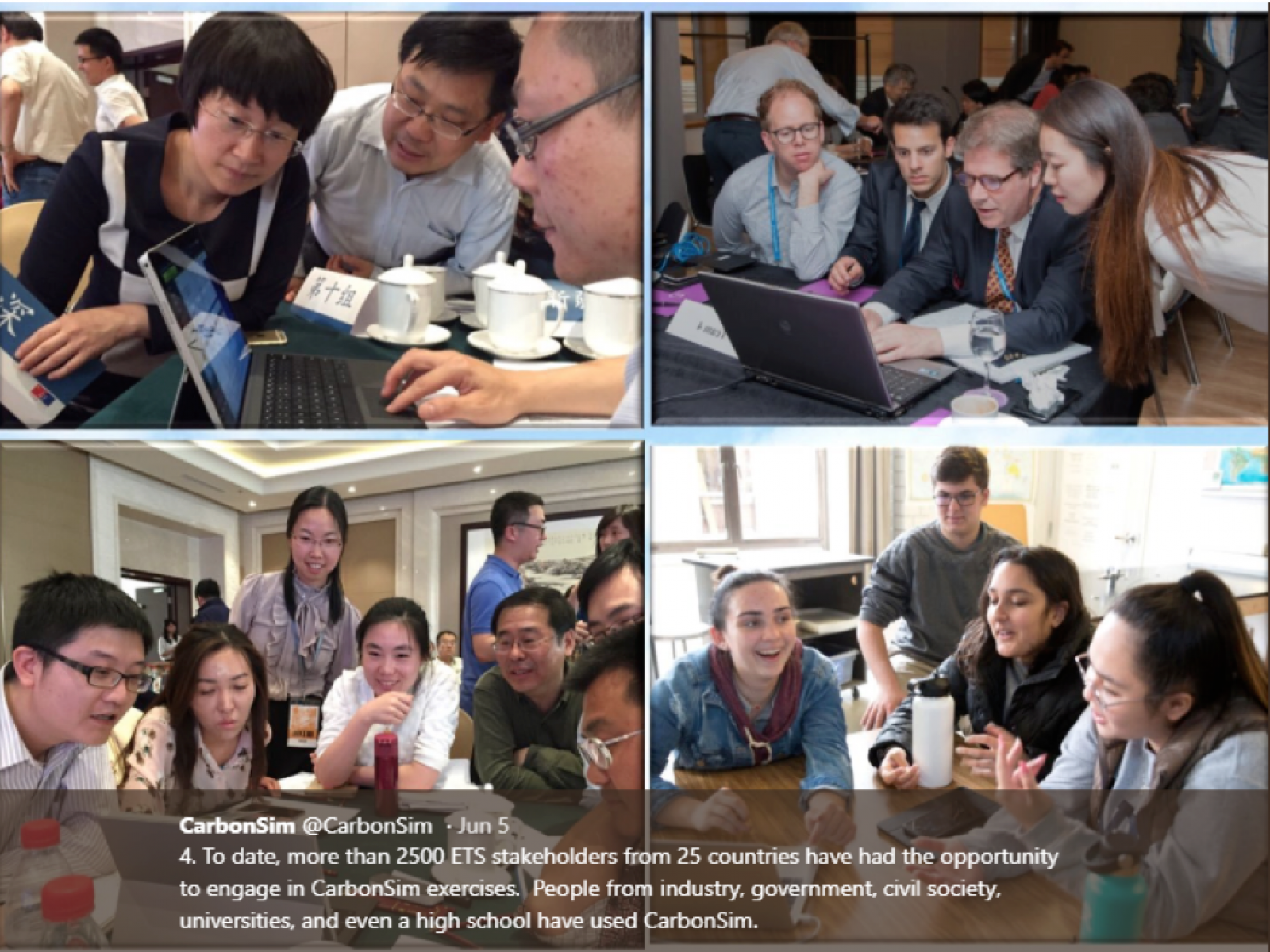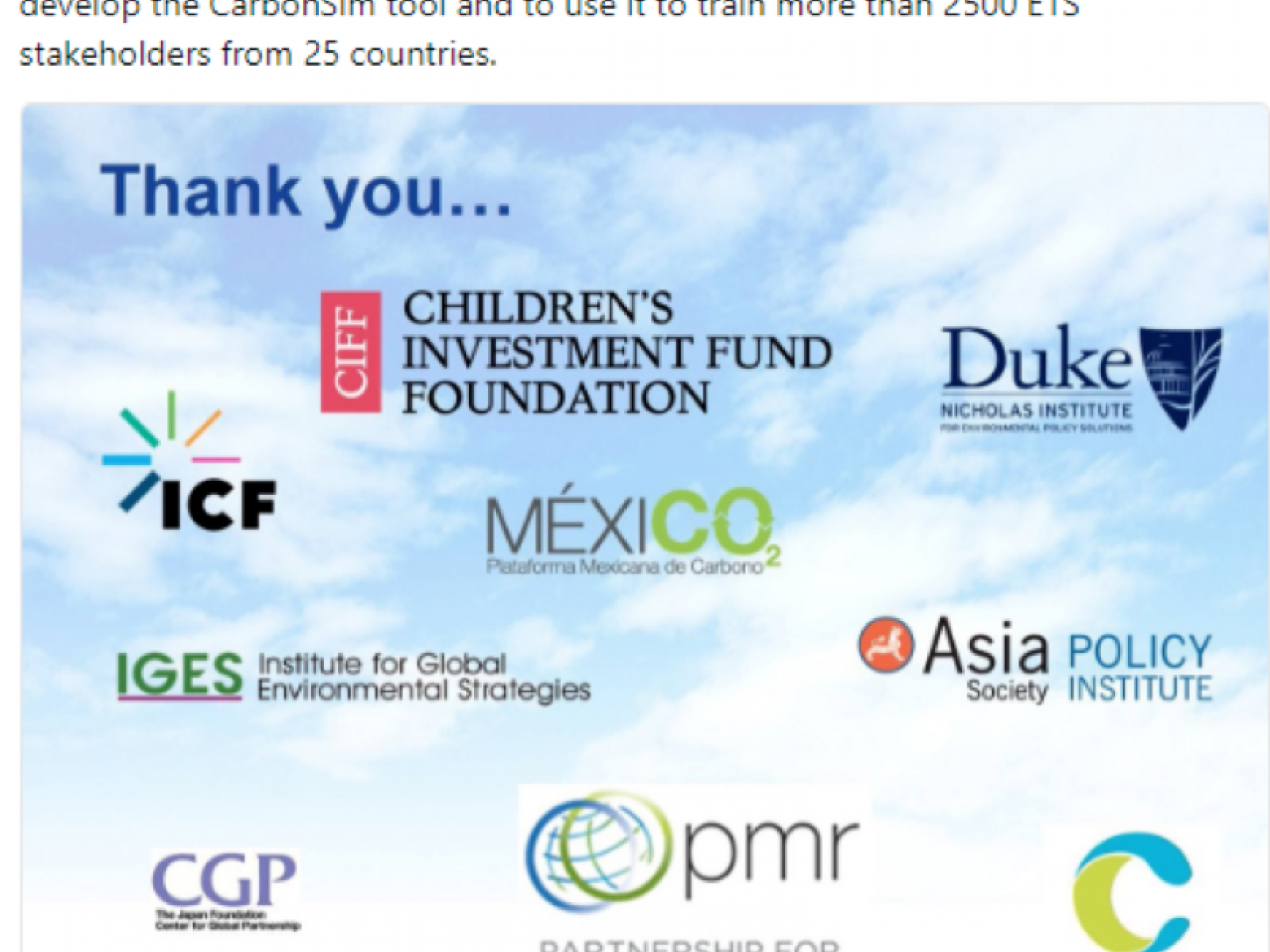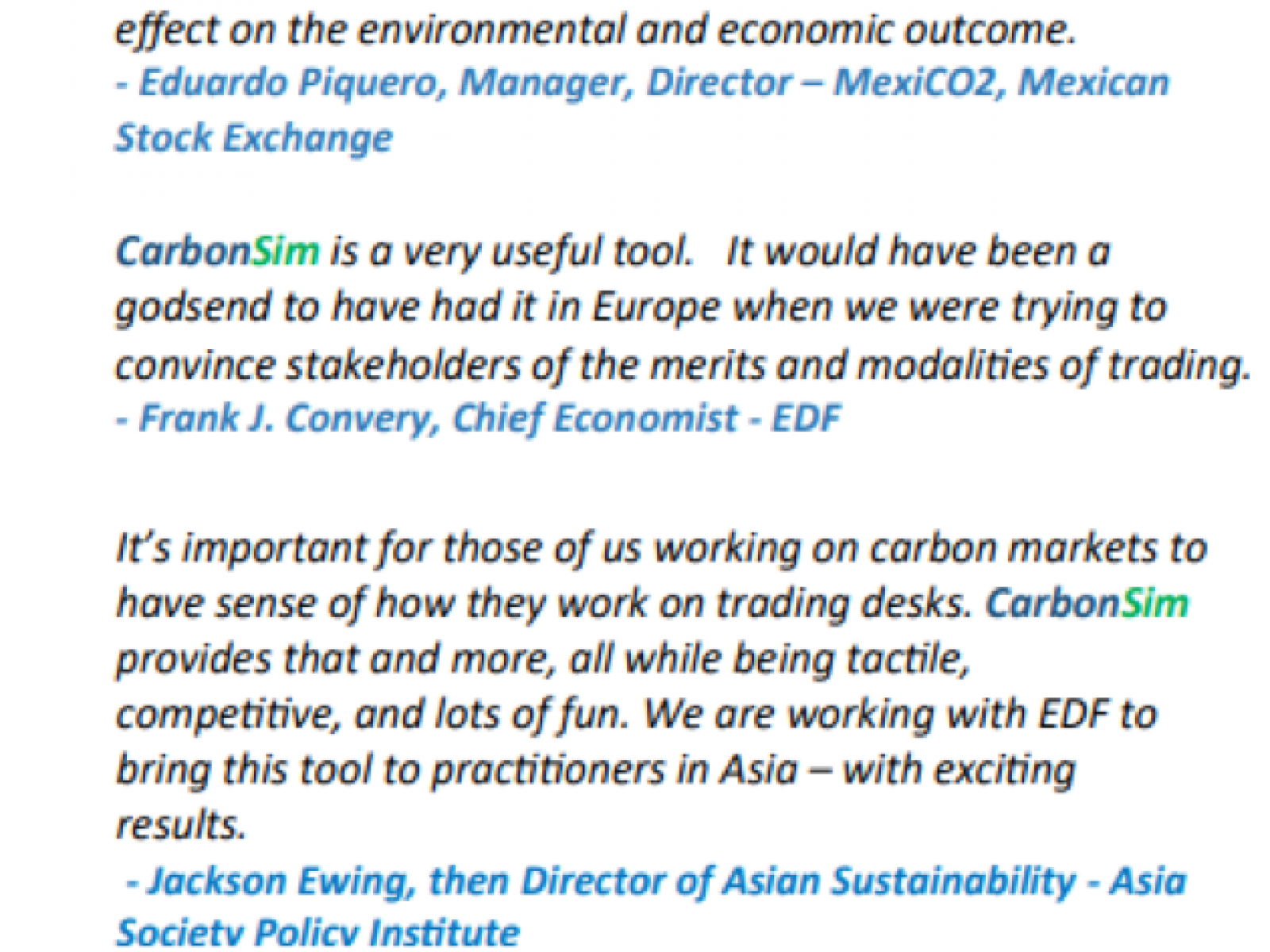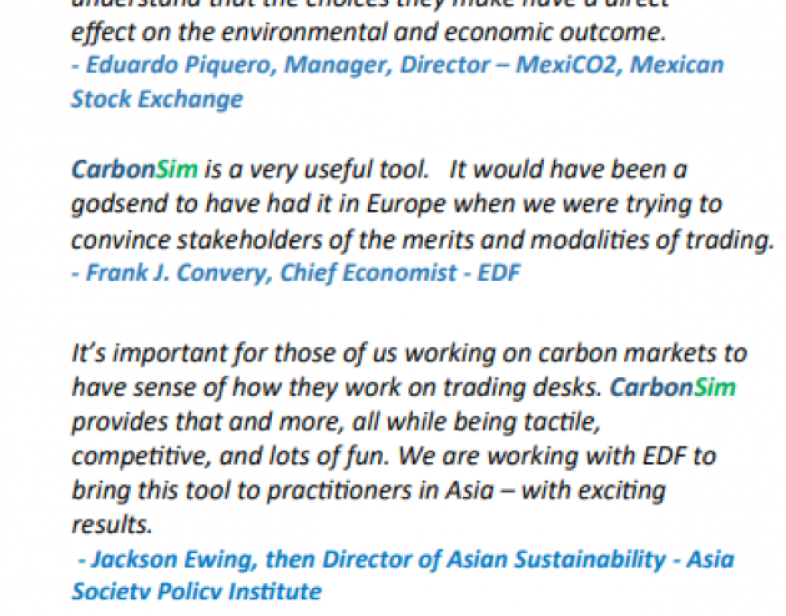An Overview Of Our Solution
CarbonSim is a collaborative, AI-enhanced educational tool designed to give users firsthand experience with carbon markets.It is ideal for policymakers, business owners, and students alike, offering immediate real-time learning about cap and trade without laborious reading and testing. It allows users to explore the feasibility and consequences of various emission trading system (ETS) designs with prompt feedback. CarbonSim challenges users to comply with realistic regulations for a growing economy by designing emissions solutions involving a combination of abatements, government-sponsored auctions, exchanges, and over-the-counter markets. With great results and glowing reviews, CarbonSim has already been used by 2,500 emissions trading stakeholders in 25 countries. It is available in five languages and can be customized with additional carbon emission data.
- Population Impacted: 2,500 individuals in 25 countries and counting
- Continent: North America
Context Analysis
The Intergovernmental Panel on Climate Change and NASA’s findings are clear – scientific evidence for the warming of our global climate system as a result of greenhouse gas emissions is unequivocal. Reducing carbon emissions is therefore essential to avoid exacerbating this global threat, but such measures stand at odds with traditional business practices. Emissions trading systems (ETS) are a method of allowing businesses the flexibility of relying on free market options while complying with new emission regulations. Many policymakers and stakeholders are resistant to this idea due to a lack of experience with how much it can accomplish, so the goal of CarbonSim is to quickly provide them with an accessible training system for navigating ETS solutions that will demonstrate their feasibility and build support for such approaches in the process. With greater understanding and acceptance of such economic tools, more sustainable business practices can be expected.
Describe the technical solution you wanted the target audience to adopt
The target audience for CarbonSim is broad, as sustainability education has universal benefits. CarbonSim’s goal is to give policymakers and industry stakeholders a quick, easy way of gaining essential firsthand experience at navigating emissions trading systems. For policymakers, this increases understanding of the challenges associated with different strategies for meeting emission regulations and promotes reasonable, practical legislation. For stakeholders, greater understanding of the pros and cons of various strategies – production, abatements, auctions, trading, and offsets – for satisfying ETS obligations improves the sustainability of industrial emissions decisions. CarbonSim gives people a safe place to explore different methods without fear of failure. Restricting learning to a simulated environment encourages learning by trial and error, improves both ETS skills and literacy,and shields the planet from policies and practices founded on a lack of experience.
Type of intervention
Describe your behavioral intervention
CarbonSim is a behavioral intervention that takes the form of an experiential immersion or simulation of designing and participating in a carbon exchange market. It is a fun, interactive gamification of an emissions trading system that provides trainees with a working understanding of ETS. In the end, participants come to understand that outcomes are a function of program design and stakeholder expertise. As a result, the theoretical becomes real. Experimentation – in policies and carbon portfolio management strategies – are run and the results are harvested. Government officials that manage, and industry that are subject to system come to understand that they have parallel interests. This triggers an attitude shift in a positive direction, and creates a social norm of participation and collaboration. Stakeholders that come into a simulation with questions and reservations emerge from the other side with optimism and excitement. To ensure the adoption of our desired behavior by individuals who can push for the adoption of an effective ETS, we have focused on showcasing CarbonSim to the environmental ministries and stakeholders of 25 different countries, who are enthusiastic about the mission and actively sharing their success stories about CarbonSim. We have also focused on producing as realistic and high-quality a product as possible, incorporating lessons learned from research associated with the US Acid Rain ETS, the EU ETS, the Western Climate Initiative,
As needed, please explain the type of intervention in more detail
As CarbonSim grows in popularity, it approaches its goal of making ETS a normative approach, while creating a standard level of literacy in these economic tools. With increasing numbers of environmental ministries and key industry players already taking part around the world, beneficial social conformity will take place and more countries will be motivated to participate. CarbonSim’s collaborative dynamic creates a salient sense of collective action, teaching players about the tragedy of the commons and fostering accountability for tackling environmental challenges jointly. Individual-level behavioral changes can help individuals feel effective in countering climate change, but implementing collective solutions reduces carbon emissions on a larger scale. The gamified trading system experience at the core of CarbonSim highlights these lessons.
Describe your implementation
Extensive research has already been conducted on how to cope most effectively with the economics of reducing climate change through carbon markets, but relatively few people have the privilege of receiving the academic training necessary to understand that work on their own. CarbonSim’s software has synthesized this broad body of knowledge into an accessible interactive format that even high school students can understand.
Overall, CarbonSim’s functionality brings players up to speed with cap and trade economic practices, including carbon abatements, government-sponsored carbon emission auctions, emissions exchanges, and over-the-counter carbon markets. Prior to the development of such teaching tools, it could have taken years of training to achieve the same results, but now CarbonSim allows participants to play through simulations that can occur over the space of hours, days, or weeks. The firsthand, interactive, and experiential aspects of CarbonSim make it much more memorable and engaging for trainees. CarbonSim has been run in collaboration with government ministries, financial exchanges, industry trade associations, individual companies, environmental NGOs, and academic institutions. It has also been presented at international climate conferences and government ministries, where participants were eager to learn how they could improve their understanding of carbon markets and the efficacy of their approaches. Satisfaction with the high quality of training CarbonSim provides has been virtually unanimous.
External connections
• Children’s Investment Fund Foundation
• The Robertson Foundation
• Mexico’s Secretariat of Environment and Natural Resources
• MexiCO2: Mexican Carbon Platform
• Chile’s Ministry of Energy and Ministry of Environment
• Thailand Greenhouse Gas Management Organization
• China’s National Development and Reform Commission
• Duke University’s Nicholas Institute
• Institute for Global Environmental Strategies
• Japan Foundation Center for Global Partnership
• World Bank Partnership for Market Readiness
• Asia Policy Society Institute
• GIZ
• The European Union
• ICF
CarbonSim was originally built with the generous support of CIFF for use in China with the goal of building capacity and informing dialogue. After early success with China, it was adapted for use in South Korea, Mexico, Chile, and Thailand. CarbonSim is an inherently applied solution linking environmental and economic research with real-world practice.
Who adopted the desired behaviors and to what degree?
CarbonSim has already been used by 2,500 emissions trading stakeholders in 25 countries. Prospective private sector ETS stakeholders have gained a working understanding of ETS that allows them to understand ETS mechanics, how to develop a carbon portfolio management strategy, and proactively engage with regulators in the design of an ETS. Likewise, participating regulators and NGOs have come to appreciate that environmental and economic outcomes are a function of ETS design. Reflecting on Mexico’s industry’s participation in CarbonSim exercises, Juan Carlos Arredondo, Mexico’s Director General for Climate Change Policies at SEMARNAT said, “This is my dream come true! Mexican industry’s level of dialogue has improved dramatically and industry is asking the government to provide them with additional training opportunities.”
How did you impact natural resource use and greenhouse gas emissions?
Quantitative data on specific emission reductions are currently unavailable, but the competitive training offered by CarbonSim in 25 countries equips users to strategically minimize their emissions. Unless technological breakthroughs reduce the emissions of a given company further, this use of carbon markets represents the lowest economically viable and robust emission level.
What were some of the resulting co-benefits?
As a result of the positive outcomes of the first 10-month phase, the Mexican government has asked CarbonSim developers at EDF to secure World Bank monies that will allow us to triple the number of companies trained. This represents a big win for sustainable development. As the result of the success of the Mexico effort, the World Bank, environmental ministries in Chile, Colombia, and Mexico are in discussions that may result in a multi-country ETS simulation. At the community level, even some high schools have had their students use CarbonSim. Educating future policymakers and industry leaders early informs the economy’s next generation, which must have sustainability at its core, rather than being retrofitted. On a broader scale, if adoption of ETS leads to their creation, that should lead to reductions in emissions that we know are harmful not just to climate, but human health. The creation of an ETS also encourages the creation of voluntary offset programs that can be used to
Sustainability
This solution has minimal expenses and is therefore certainly economically sustainable. Now that the software has been developed, it relies on the interest and awareness of potential participants and has no operation costs.
Return on investment
The initial development of the CarbonSim tool involved an investment of ~$150k. Over the course of four years we have made additional capital investments that have allowed us to improve the tool and make it more accessible. Initially the tool could be used by 35 people in the same classroom, in two languages. Currently, CarbonSim can be simultaneously be run in five languages, using >10 currencies, and accessed simultaneously by players located around the globe with WiFi access on their laptops or their phones. The cost per simulation – and the quality of each simulation – has dropped markedly over time.
How could we successfully replicate this solution elsewhere?
Successful replication of this solution depends on the ability of previous participating stakeholders to unite and contact their economic partners to deliver a direct message about how CarbonSim has benefited them. This will leverage group pressure for better environmental behavior as well as the principle of social proof if all participants are clear about how CarbonSim has improved their understanding of ETS. This solution has already been replicated in 5 countries, and benefited from the cooperation of the Asia Society Policy Institute, Duke University Nicholas Institute School of the Environment, MexiCO2 - A Carbon Trading Platform of the Mexico Stock Exchange, the Mexican Secretariat of Environment and Natural Resources, the Chilean Ministry of Energy, the European Commission, the South Korean Government, the Japan Foundation Center for Global Partnership, and many other environmental organizations.






